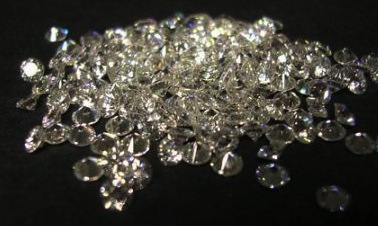Supercomputer at CSCS Demonstrates How Diamonds Emerge from Graphite
The Swiss National Supercomputing Centre (CSCS) reported today how the group of professor Michele Parrinello demonstrated how diamonds emerge from graphite by using the Monte Rosa Cray XT5 supercomputer. For the first time ever the researchers have used a new method to precisely simulate the phase transition from graphite to diamond. Instead of happening concerted, all at once, the conversion evidently takes place in a step by step process involving the formation of a diamond seed in the graphite, which is then transformed completely at high pressure.
The contrast between the naturally occurring forms of elemental carbon – as grey-black graphite or sparkling diamond – is greater than for almost any other material. The substantial difference between the two forms is mainly due to their crystal structure, which is cubic in the case of diamond and hexagonal for graphite. This gives rise to the different properties of the two materials and makes diamond the hardest known material, alongside the comparatively soft graphite. This is why diamonds are not only in demand as an attractive gemstone but are also important as an industrial tool, e.g. for grinding or sawing.
An uncomfortable transition
The artificial production of diamond from graphite was first achieved around 60 years ago. However, the high pressure and high temperatures needed to produce diamond are among the reasons why graphite is not converted into diamond on a large scale. The process is time-consuming and energy-intensive, because the manufacture of synthetic diamonds requires forcing the inexpensive carbon to change its bonding structure and thus the arrangement of its electrons. It must form four bonds instead of three, and must change from an energetically “comfortable” state to an “uncomfortable” one. To do this the carbon must overcome a large energy barrier.
Knowing exactly how this conversion occurs, and when the carbon changes into diamond, is important for materials research but was unclear until now. Michele Parrinello, Professor of Computational Science at ETH Zurich and the Università della Svizzera italiana in Lugano, and his team have developed a method with which they have successfully simulated this phase transition accurately and adequately using computer models.
Simplification yields a false picture
In the past, scientists tried to model the phase transition by using the so-called Car-Parrinello method (see article describing this method »). This approximately determines the structure and energy state of the electrons for each position in the ion to enable the simulation of bonds that break and re-form. The procedure is based on a method developed by Parrinello in collaboration with Roberto Car more than 25 years ago. “However, so many atoms need to be taken into account in the phase transition from graphite to diamond that an exact simulation would be too expensive,” says Parrinello. This is why, until now, the researchers resorted to a simplified method by carrying out the simulation with far fewer atoms, but according to Parrinello this caused the models to give the impression that the whole of the graphite changed into diamond all at once, as if on command.
However, the new method now shows a different picture of the process. The scientists used the supercomputer at CSCS (the Swiss National Supercomputing Centre) to calculate tens of thousands of configurations of atoms with slightly differing energy states. This means that the atomic configurations cover a broad spectrum of possible energy states. After the scientists had interpolated their energy states and used this as a basis for their simulation, it became apparent that first of all a diamond seed is formed, and at high pressure this progressively converts the hexagonal crystal structure of the graphite into a cubic one.
Simulating the phase transition with the new method also revealed that structural defects in the graphite crystal lattice reduce the energy barriers that have to be overcome in order to form a diamond seed. Structural defects can therefore speed up the conversion process. “The method can be used wherever there is a need to visualise phase transitions,” Stresses Parrinello.
Literature reference:
Khaliullin, RZ, Eshet, H, Kühne, TD, Jörg Behler, J & Parrinello, M: Nucleation mechanism for the direct graphite-to-diamond phase transition, Nature Materials (2011), 10, 693–697, DOI: doi:10.1038/nmat3078


